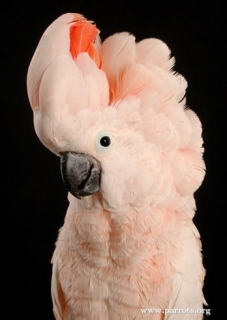Moluccan Cockatoo |
|
|
Also known as: Salmon-crested Cockatoo, Pink-crested Cockatoo, Rose-crested Cockatoo
Photos
View in GalleryDid You Know?
The Moluccan Cockatoo is found only on Seram and Ambon in Indonesia.Programs & Projects
WPT has worked with numerous partners to help save this species. Learn moreAcademic Research
Related publications: Cacatua moluccensisSpecies Profile
Genus: Cacatua | Species: moluccensis
Size:
40-50 cm (15.6-19.5 in)
Weight:
775-935g (27.1-32.7 oz)
Subspecies including nominate:
one
Colour Adult:
Both adults large, soft peach coloured cockatoo with bright, dark peach crest; soft yellow suffusion underwings and undertail. Eye black, area around eye white. Eye black in male and dark brown in female.
Colour Juvenile:
As in adult.
Call:
Shrill screech with quavering notes; are vocal most of all in evening.
Listen NowVideo Links:
Video 1 | Video 2More Information:
Content Sources:
CITES
BirdLife International
Cornell Lab of Ornithology/Birds of the World
A Guide to Parrots of the World, Juniper and Parr, 1998
Parrots: Status Survey and Conservation Plan 2000-2004, Snyder, McGowan, Gilardi and Grajal, 2000.
Parrots of the World, Forshaw and Cooper, 1989.
Parrots of the World, Forshaw, 2006.
Parrots in Aviculture, Low, 1992.
Avian Pediatric Seminar Proceedings, various authors, 1988.
Photos
View in GalleryDid You Know?
The Moluccan Cockatoo is found only on Seram and Ambon in Indonesia.Programs & Projects
WPT has worked with numerous partners to help save this species. Learn moreAcademic Research
Related publications: Cacatua moluccensisSpecies Care
Captive Status:
Fairly common
Longevity:
40-60 yrs
Housing:
Walk-in aviary, minimum length 4.5m (14.7 ft).
Diet:
Small seed mix such as: canary, oats, safflower and small amount of hemp, spray millet, limited sunflower seed, dry, soaked or sprouted; sprouted beans such as mung or peas, cooked butterbeans or lentils, boiled or fresh corn, green leaves of spinach, Swiss chard, lettuce, sowthistle, dandelion and chickweed; fresh vegetables such as carrot, celery, zucchini, squash, green beans and peas in a pod; fresh fruit such as apple, pear, orange, banana, cactus fruits, pomegranates, berries, asian pears, kiwi fruit, and others; nutritionally complete kibble, high protein biscuits for underweight birds.
Enrichment:
Chewable objects - sterilized pine cones, fir, pine, willow or elder branches, vegetable tanned leather items; hard plastic puzzle items, food finders, push and pull toys, different size perches, socialization. Enjoys bathing so provide overhead misters or use spray bottle.
Nest Box Size:
75cm (29") high, 60cm (23.4") in diameter, barrel shaped.
Clutch Size:
2
Incubation Time:
28 days
Fledging Age:
15 weeks
Hatch Weight:
16-20g (0.5-0.7 oz)
Peak Weight:
896-943g (31.4-33 oz)
Weaning Weight:
822g (28.8 oz)
Photos
View in GalleryDid You Know?
The Moluccan Cockatoo is found only on Seram and Ambon in Indonesia.Programs & Projects
WPT has worked with numerous partners to help save this species. Learn moreAcademic Research
Related publications: Cacatua moluccensisSpecies Wild Status
World Population:
As few as 10,000
IUCN Red List Status:
Vulnerable
CITES Listing:
Appendix I
Threat Summary:
Wild bird trade (baseline estimates suggest 4,000 birds are removed from the wild annually in domestic trade), deforestation and habitat loss.
Range:
S Moluccas (Seram; formerly Saparua and Haruku) and Ambon, Indonesia.
Habitat:
Lowland forest between 100-1200m (328-3936 ft). Found in undisturbed and disturbed primary lowland forest with large trees, also open canopy forest with low vegetation.
Wild Diet:
Feeds on nuts, young coconut, seeds, berries, and insects and their larvae.
Ecology and Behaviour:
Found in noisy roosts, during breeding season found singly or in pairs; at other times found in groups of up to 16 birds. Generally shy species. Active early morning and late afternoon.
Clutch and Egg Size:
2 elliptical eggs, size 30.0 x 50.0mm (1.2 x 2 in).
Breeding Season:
Begins in July, August. Nest is high up in tree hollow.
Related Links:
Wikipedia
Research: Density and distribution of the endemic Seram Cockatoo in relation to land use patterns
Photos
View in GalleryDid You Know?
The Moluccan Cockatoo is found only on Seram and Ambon in Indonesia.Programs & Projects
WPT has worked with numerous partners to help save this species. Learn moreAcademic Research
Related publications: Cacatua moluccensisMembers Only Resources
Please log-in now to find more research, resources and tools.
Not a Member?
Find more great information:
Gain exclusive access to 600+ pages of additional research, seminars and podcasts, specialists to ask your toughest questions, and dozens of other fun resources - when you become a WPT member.
Join Today >>

































